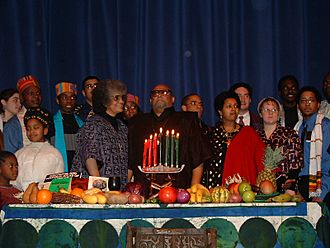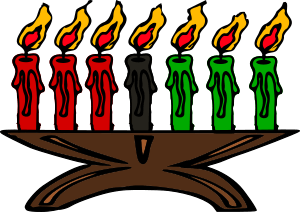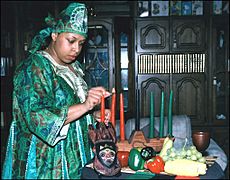Kwanzaa facts for kids
Quick facts for kids Kwanzaa |
|
|---|---|

Kwanzaa celebration with its founder, Maulana Karenga, and others
|
|
| Observed by | African Americans |
| Type | Cultural and ethnic |
| Significance | Celebrates Black heritage, unity and culture. |
| Celebrations | Unity Self-Determination Collective Work and Responsibility Cooperative Economics Purpose Creativity Faith |
| Date | December 26 until January 1 |
| Related to | Black History Month |
Kwanzaa is a week-long celebration held in the United States to honor African heritage and culture. People light a kinara (candle holder with seven candles) and give each other gifts. It takes place from December 26 to January 1 every year. It was created by Maulana Karenga and was first celebrated in 1966 - 1967. Some non-African Americans also celebrate Kwanzaa. The holiday greeting is "Joyous Kwanzaa."
Contents
History and name of the holiday
Kwanzaa is a celebration that started in the black nationalist movement of the 1960s. It was created as a way to help African Americans reconnect with their African cultural and historical heritage.
During the early years of Kwanzaa, Karenga said it was meant to be an alternative to Christmas because Christianity was a white religion that black people should shun. However, as Kwanzaa became more popular, Karenga said that changed his point of view so that practicing Christians could also feel included.
The name Kwanzaa comes from the Swahili phrase matunda ya kwanza, meaning "first fruits". First fruits festivals exist in Southern Africa and are celebrated in December/January with the southern solstice. Karenga was partly inspired by an account he read of the Zulu festival Umkhosi Wokweshwama. It was decided to spell the holiday's name with an additional "a" so that it would have a symbolic seven letters.
Principles and symbols
Kwanzaa celebrates what its founder called the seven principles of Kwanzaa, or Nguzo Saba (originally Nguzu Saba—the seven principles of blackness). Each of the seven days of Kwanzaa is dedicated to one of the following principles, as follows:
- Umoja (Unity): To strive for and to maintain unity in the family, community, nation, and race.
- Kujichagulia (Self-Determination): To define ourselves, name ourselves, create for ourselves, and speak for ourselves.
- Ujima (Collective Work and Responsibility): To build and maintain our community together. To make our brothers' and sisters' problems our problems, and to solve them together.
- Ujamaa (Cooperative Economics): To build and maintain our own stores, shops, and other businesses and to profit from them together.
- Nia (Purpose): To make our collective goal the building and developing of our community. This is in order to restore our people to their traditional greatness.
- Kuumba (Creativity): To do always as much as we can, in the way we can. This is so that we can leave our community more beautiful and better than we inherited it.
- Imani (Faith): To believe with all our heart in our people, our parents, our teachers, our leaders, and the righteousness and victory of our struggle.
Kwanzaa symbols include a decorative mat on which other symbols are placed, corn and other crops; a candle holder with seven candles, called a kinara; a communal cup for pouring libations; gifts; a poster of the seven principles; and a black, red, and green flag. The symbols were designed to show the seven principles.
During Kwanzaa, families decorate their households with objects of art. They use colorful African cloth such as kente, especially the wearing of kaftans by women. Fresh fruits that represent African idealism are also used. It is normal to include children in Kwanzaa ceremonies and to give respect and gratitude to ancestors. Libations are shared, generally with a common chalice (a shared cup), Kikombe cha Umoja, passed around to all people present. A Kwanzaa ceremony may include drumming and musical selections, libations, a reading of the African Pledge and the Principles of Blackness, reflection on the Pan-African colors, a discussion of the African principle of the day, or a chapter in African history, a candle-lighting ritual, artistic performance, and finally, a feast (Karamu). The greeting for each day of Kwanzaa is Habari Gani? which is Swahili for "What's the news?"
Cultural exhibitions include the Spirit of Kwanzaa, an annual celebration held at the John F. Kennedy Center for the Performing Arts featuring interpretive dance, African dance, song, and poetry.
Interesting facts about Kwanzaa
- In the kinara, the one black candle represents the unity of the people.
- The three green candles represent the future of African lands and communities.
- The three red candles represent the past bloodshed from African ancestors.
- *The first US postage stamp to recognize Kwanzaa was issued in 1997.
- "Kwanzaa is not a religious holiday, but a cultural one." ~Maulana Karenga
Images for kids
-
A 2003 Kwanzaa celebration with Kwanzaa founder Maulana Karenga at the center, and others
See also
 In Spanish: Kwanzaa para niños
In Spanish: Kwanzaa para niños






